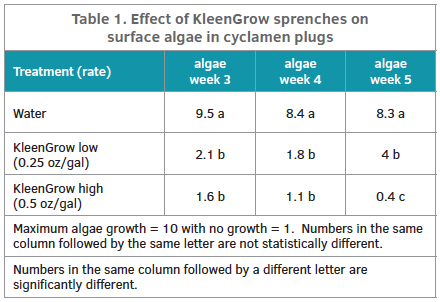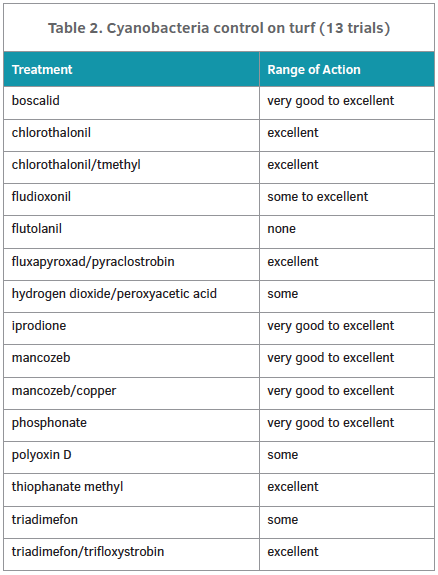Update on Algae Control on Ornamentals
One of the worst problems faced by ornamental growers worldwide is masses of slimy green algae that grow on pots, soil, benches, walkways, and even all over plant leaves and stems. There are many, many types of algae from the cyanobacteria (blue-green algae) that invade turf to plant parasites like Cephaleuros and finally the myriad opportunists that are found especially in greenhouses and shade houses in the warmer regions. There are even algae that are part of the biofilms that coat the interior walls of irrigation lines.
The high moisture, light and temperature so abundant throughout the greenhouse industry are ideal for algal growth. Excess nutrients are rapidly utilized by these opportunists. Even when fertilizer is applied sparingly and directly to plants a certain amount is not used by the plant and provides food for the algae.
Methods used to control algae differ depending on the surface where they grow. Walkways, irrigation lines, containers and benches can be treated with some chemicals that are very toxic to plants. Sodium hypochlorite (commercial bleach), copper, peroxide combinations, acids and quaternary ammonium compounds are used to clean algae and other microbes from these nonliving surfaces. In addition, algae control in cooling pads is generally achieved with chemicals, especially the quaternary ammonium compounds which do not degrade the metals and other materials that comprise the cooling pads.
ALGAE CONTROL ON SURFACES
A study performed in Canada compared eight disinfectants for efficacy against a wide range of plant pathogens, corrosive nature and plant safety. The products included (in order of highest efficacy against fungal and bacterial pathogens): KleenGrow, bleach, Biosentry, Virkon, ECA Water, OxiDate, MENNO-Florades and Hyperox 324. When evaluated for corrosiveness, these were highest to lowest: bleach, Virkon, Hyperox, Oxidate, Biosentry, Menno-florades, ECA water and Kleengrow. For plant toxicity from safest to most phytotoxic, they were: ECA water, Hyperox, MENNO-Florades, KleenGrow, Virkon, bleach and Biosentry.
A Canadian trial performed by Janice Elmhirst, Elmhirst Diagnostics & Research, over 10 years ago evaluated how effective KleenGrow 7.5 percent DDAC was in preventing algae growth in cyclamen plug production. KleenGrow was applied at 0.25 ounce/ gallon as a seed-dip followed by a post-seeding sprench (a foliar spray applied in sufficient water to also drench the root zone) every 14 days in the greenhouse at 0.25 or 0.5 ounce/gallon (Table 1). This treatment resulted in 94 to 100 percent control of cyclamen seedling loss from Botrytis grey mold blight (Botrytis cinerea) and Fusarium crown and root rot (Fusarium oxysporum). The sprench (2 milliliters/liter every 14 days) reduced algal growth on seedling flat surfaces by up to 80 percent (Table 1). This work was repeated with similar results.

A more recent trial by Michael R. Evans, University of Arkansas, evaluated safety on lettuce seedlings as well as algal control. Evans used KleenGrow (DDAC), Selectrocide (chlorine dioxide) and a copper product each at two rates. None of the disinfectants tested had any statistical effect on germination and growth of Rex lettuce seedlings at the two- and four-leaf stage. KleenGrow provided the best algae control at both rates tested followed by Selectrocide at the high rate (Figure 2).
Peter Konjoian, Konjoian’s Horticulture Education Services Inc., has also been busy testing products for control of algae in recirculated water. Flood benches that were heavily infested with algae showed a rapid and significant decrease in algae following weekly applications of KleenGrow 7.5 percent (DDAC) at 0.25 or 0.5 ounce/gallon (Figure 1). These treatments prevented the formation of new algae on the pot surface also. Plants treated with KleenGrow at 0.25 ounce/gallon per week showed no signs of damage while some stunting of growth and/or curled leaves or leaf edge browning developed on plants treated with 0.5 ounce/gallon per week.
ALGAE CONTROL ON PLANTS
There are a number of fungicides that work on other forms of algae in other situations and they could be helpful in controlling the algae that grow on the surface of our potting media and even on the plant leaves. Algae control on plants has been tested using a variety of “fungicides” including the copper products (such as Camelot, Kocide and Phyton 27), dithiocarbamates (such as Dithane or Protect) and quaternary ammoniums. Results vary depending on sensitivity of the plant and type of algae present.
In the late 1980s, when I worked at the University of Florida, we did some algae control tests on foliage plants. The products we tested were primarily fungicides and some actually worked pretty well without damaging the crops in the containers (all foliage plants). A real concern is that you cannot drench with carbamates or chlorothalonil since they can cause phytotoxicity in the roots and damage the crop. The most effective product was dodine which is no longer available — naturally. Bleach was effective, but regrowth started immediately and it was very phytotoxic causing severe damage to leaves and even leaf drop.
Extensive studies on turf for control of cyanobacteria (blue green algae; Prokaryotic cyanobacteria) has focused on use of fungicides. Despite the name, they are not bacteria as we think of the single celled microorganisms that cause bacterial diseases on our plants. Two of the cyanobacteria that have been identified as problematic in turf and also ornamental production are Nostoc and Oscillatoria. In nursery crop production, some trialing has been completed with pre-treatment herbicides in the absence of the crop.
While little work has been done on ornamental crops, quite a few trials have been run on cyanobacteria on turf (Table 2). The productsthat have been tested are all fungicides. A summary of 13 turf trials showed that the following provided excellent suppression of cyanobacteria colonization of turf: chlorothalonil, thiophanate methyl, Orkestra Intrinsic and Trigo. In addition, very good to excellent control was provided with iprodione, mancozeb (alone or with copper) and a phosphonate. Products that were only slightly effective were: hydrogen dioxide/peroxyacetate, polyoxin D and triadimefon alone.

Another example of an algal problem that occurs on many tropical and semi-tropical crops and landscape plants is algal leaf spot. The culprits are species of Cephaleuros. Some of them grow on the leaf or stem surface but others are not so benign. Cephaleuros parasiticus actually attacks the plant tissues, growing inside the leaves like a fungus causing leaf spots. One crop that has received some attention is blackberry, which has a disease called orange cane blotch (Cephaleuros virescens). The following fungicides were evaluated for control with four weekly applications: Oxidate, Bravo, Kocide 3000, ProPhyt, Dithane, Junction and 10 percent bleach. The only product that was significantly effective was ProPhyt. In another trial, the same researchers compared a number of products (Oxidate, Dithane and ProPhyt) alone and with either Kocide or ProPhyt. Overall, all products worked better when ProPhyt was part of the tank mix but Kocide did not improve control when it was added.
In 2017, two IR-4 trials were reported by Fulya Baysal-Gurel (Tennessee State University) where she attempted control of algal leaf spot on magnolia with fungicides. Results in Figure 3 show the trial with moderate-high pressure. All products significantly reduced algal leaf spot on the magnolias. The best control was seen with Mural and KleenGrow followed closely by Daconil Ultrex.
CONCLUSIONS
The trials I summarize and report here are the most recent and/or applicable to control algae on ornamental crops. Little of the work was done directly on an ornamental crop in a greenhouse setting. Therefore, testing possible benefits of using any of these products in ornamental greenhouse production is 100 percent up to you — the grower.
Based on all of this research, the most likely products to trial for algae control directly on your crops are:
- carbamates like mancozeb (do not sprench/drench)
- chlorothalonil (do not sprench/drench)
- iprodione (safe to sprench/drench)
- KleenGrow (use lowest rate to check safety on plugs)
- Mural (safe to sprench/drench)
- Orkestra Intrinsic (safe to sprench/drench)
- phosphonate (safe to sprench/drench)
- thiophanate methyl (safe to sprench/drench)
- Trigo (do not sprench/drench
I listed the specific products when they are proprietary combinations (Mural, Orkestra Intrinsic and Trigo) or a specific formulation (KleenGrow). Keep in mind always that the label is the law. I doubt any of these fungicides is legally labeled for algae control with the exception of chlorothalonil on turf and KleenGrow, which is appropriate and labeled for these uses. Be sure to trial them for safety, efficacy and legality by checking labels before broad-scale use.


 Video Library
Video Library 




















